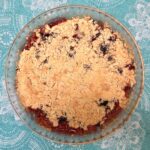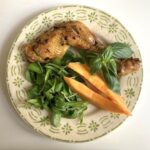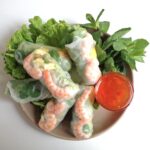 French fish soup is a deeply flavorful dish that is traditionally served with rounds of toast, grated cheese and rouille, a garlic mayonnaise flavored with saffron and cayenne. Unlike other fish soups, this one comes to the table totally smooth, without any pieces of fish. In the classic version, fresh fish are cooked, bones and all, with veggies and herbs, and the soup is passed through a sieve. One can simplify by using fish fillets, fresh or frozen.
French fish soup is a deeply flavorful dish that is traditionally served with rounds of toast, grated cheese and rouille, a garlic mayonnaise flavored with saffron and cayenne. Unlike other fish soups, this one comes to the table totally smooth, without any pieces of fish. In the classic version, fresh fish are cooked, bones and all, with veggies and herbs, and the soup is passed through a sieve. One can simplify by using fish fillets, fresh or frozen.
Soupe de poisson / French fish soup
This soup is served across France in numerous iterations, but the basic recipe follows the same lines. Onion, garlic, leek, finocchio and tomatoes are sautéed to tenderness in olive oil; water, herbs and seasonings are added to make a broth; the fish are simmered in the broth; and the soup is then blended and strained.
French fish soup may be made with many types of fish. Julia Child’s recipe lists 11 varieties, including cod, perch, mullet, sea bass and turbot (although it’s kind of shame to use the higher priced varieties in a soup). My favorite Provençal cookbook simply says to use rockfish, which are cheap and abundant in the Mediterranean but not necessarily available elsewhere. If you’d like to make fish soup and you’re not in southern France, you can use any local variety of fish as long as it’s lean (non-oily).
In the soup shown in the photo above, I used merlan (hake) and vive (weever) on the advice of my local fishmonger. I asked him to gut the fish and remove the heads and tails, although these are sometimes included in the broth. My plan was to cook the soup and then purée it in the blender — but, dear reader, that didn’t work. When I tasted the purée, it was full of tiny pieces of fishbone. So I strained it through a sieve, as most French recipes advise. Success. No bones, and a flavor that I can only describe as sublime.
 The color of French fish soup can vary from salmon pink to rusty red, most likely a result of the type and amount of tomatoes used. Mine came out pink, probably because it’s autumn and fresh tomatoes are less red and ripe than in mid-summer. The soup may also be made with tinned tomatoes.
The color of French fish soup can vary from salmon pink to rusty red, most likely a result of the type and amount of tomatoes used. Mine came out pink, probably because it’s autumn and fresh tomatoes are less red and ripe than in mid-summer. The soup may also be made with tinned tomatoes.
French fish soup is not to be confused with bouillabaisse, the fabulous dish from Marseille, in which a platter of fish and shellfish is brought to the table to be served after the soup. I’ve been planning to post that recipe for a while, the problem being that it is hard to produce a bona fide bouillabaisse if one doesn’t live within range of the Mediterranean. But maybe one of these days…
As for the regional variations, in southern France it’s traditional to include a piece of dried orange rind in the broth. Sometimes saffron and/or cayenne are added as well. In Normandy and Brittany, celery might be substituted for the finocchio, and carrots may be included. But the tradition of serving the soup with croûtons (toasted bread rounds), rouille and grated cheese is followed throughout the country.
I don’t make French fish soup very often, both because it’s a bit of a production and because it’s available here in bottles — the quality is quite all right. But I can assure you that the homemade variety is very far superior, and worth the effort.
Happy cooking.
P.S. Just letting you know that I will be posting once every three weeks (instead of once every two weeks) from now until after the holidays. This is because I have a new book coming out in early December! More on that in my next post…

 This sophisticated French take on the burger is made of ground veal flavored with grated Comté cheese, garlic and herbs, then lightly breaded and fried. Serve it on a bun, and it becomes child friendly. But it also makes a surprisingly elegant main dish that marries well with anything from pasta to veggies to salad. And despite its name, which makes it sound like an Italian dish from Milan, this dish is totally French — and rather unusual.
This sophisticated French take on the burger is made of ground veal flavored with grated Comté cheese, garlic and herbs, then lightly breaded and fried. Serve it on a bun, and it becomes child friendly. But it also makes a surprisingly elegant main dish that marries well with anything from pasta to veggies to salad. And despite its name, which makes it sound like an Italian dish from Milan, this dish is totally French — and rather unusual. It’s the tail end of summer, so let’s make pickles! Not the tiny, vinegary French kind, but home-style dill pickles with an East European flavor. I am dedicating this post to my Ukrainian friend Valya, who returned to Kyiv this week after three-and-a-half years as a war refugee in Paris. It’s as dangerous there as ever, but for her it was just time to go home. I made these pickles for her as part of the picnic I gave her for her two-day bus journey back.
It’s the tail end of summer, so let’s make pickles! Not the tiny, vinegary French kind, but home-style dill pickles with an East European flavor. I am dedicating this post to my Ukrainian friend Valya, who returned to Kyiv this week after three-and-a-half years as a war refugee in Paris. It’s as dangerous there as ever, but for her it was just time to go home. I made these pickles for her as part of the picnic I gave her for her two-day bus journey back. Four hours later you can already try your pickles! They’ll be crunchy, with plenty of flavor. If you’d rather save them for later, you can transfer them to a clean jar and refrigerate for up to a week — no sterilization needed. It’s also possible to preserve the pickles by canning, but this is a far more complicated procedure. Many sites online explain how to do it, if you’re interested.
Four hours later you can already try your pickles! They’ll be crunchy, with plenty of flavor. If you’d rather save them for later, you can transfer them to a clean jar and refrigerate for up to a week — no sterilization needed. It’s also possible to preserve the pickles by canning, but this is a far more complicated procedure. Many sites online explain how to do it, if you’re interested. An artist, she went out every day to draw and paint Paris. Here is one of her works. It shows Marianne, the symbol of the French republic, draped in a Ukrainian flag. Valya made the sketch at the Place de la République shortly after a pro-Ukraine demonstration when people still thought the war would be brief. She gave it to me for my birthday three years ago. And the war goes on…
An artist, she went out every day to draw and paint Paris. Here is one of her works. It shows Marianne, the symbol of the French republic, draped in a Ukrainian flag. Valya made the sketch at the Place de la République shortly after a pro-Ukraine demonstration when people still thought the war would be brief. She gave it to me for my birthday three years ago. And the war goes on… It’s blackberry season and, when down in Provence last week, I couldn’t resist the temptation to make a blackberry-nectarine crumble. The two fruits married beautifully. Blackberries on their own would have been difficult because Provence got hammered by extreme heat and dry weather this summer. The blackberries on the bushes lining the road near my friends’ place were less plump and juicy than usual, and fewer and farther between.
It’s blackberry season and, when down in Provence last week, I couldn’t resist the temptation to make a blackberry-nectarine crumble. The two fruits married beautifully. Blackberries on their own would have been difficult because Provence got hammered by extreme heat and dry weather this summer. The blackberries on the bushes lining the road near my friends’ place were less plump and juicy than usual, and fewer and farther between. So now let’s leave this thorny subject (pun intended, sorry) and return to our two-fruit crumble. To tell you the truth, I cheated a little by adding some store-bought blackberries, which are far larger than the fruit one finds growing wild and therefore suspect, in my view. However, in this case it made for a juicier crumble. You can improvise, too — with peaches instead of nectarines, or blueberries instead of the mûres, or whatever strikes your fancy.
So now let’s leave this thorny subject (pun intended, sorry) and return to our two-fruit crumble. To tell you the truth, I cheated a little by adding some store-bought blackberries, which are far larger than the fruit one finds growing wild and therefore suspect, in my view. However, in this case it made for a juicier crumble. You can improvise, too — with peaches instead of nectarines, or blueberries instead of the mûres, or whatever strikes your fancy. Move over, potato pancakes. This lighter, summery version with zucchini is perfect in hot weather. The pancakes combine grated zucchini and potato with egg and plenty of herbs — mint is my favorite. Fried in olive oil until crispy and golden, they may be served on their own or with a tangy yogurt-garlic sauce. You can make them in half an hour for a couple of people. Or, if serving for a crowd, make a lot — you’ll find them going like pancakes…
Move over, potato pancakes. This lighter, summery version with zucchini is perfect in hot weather. The pancakes combine grated zucchini and potato with egg and plenty of herbs — mint is my favorite. Fried in olive oil until crispy and golden, they may be served on their own or with a tangy yogurt-garlic sauce. You can make them in half an hour for a couple of people. Or, if serving for a crowd, make a lot — you’ll find them going like pancakes… Grilled chicken with rosemary and thyme is one of the delights of the summer season, particularly if you have access to a barbecue — but even if you don’t, as I experienced once again last weekend while staying at a friend’s place in Normandy. We marinated the chicken in olive oil, lemon juice, minced garlic and the herbs, fresh from her garden. We had planned a barbecue, but alas the heavens opened. So we grilled it in the oven. Ab fab…
Grilled chicken with rosemary and thyme is one of the delights of the summer season, particularly if you have access to a barbecue — but even if you don’t, as I experienced once again last weekend while staying at a friend’s place in Normandy. We marinated the chicken in olive oil, lemon juice, minced garlic and the herbs, fresh from her garden. We had planned a barbecue, but alas the heavens opened. So we grilled it in the oven. Ab fab… The green olive spread from Provence known as tapenade verte is delightful at cocktail hour on warm summer evenings. Like its cousin,
The green olive spread from Provence known as tapenade verte is delightful at cocktail hour on warm summer evenings. Like its cousin,  If you prefer white, choose a crisp, fruity variety. Or you may like to serve pastis, the oh-so-Provençal anise-flavored apéritif. Pastis, of which there are many varieties (Ricard, Casanis, Pernod, etc.), comes out of the bottle deep yellow but turns a cloudy pale yellow when water is added. Pour about an inch (2.5 cm) of it into a glass, add ice and top up with water. This goes brilliantly with tapenade — green, black or both.
If you prefer white, choose a crisp, fruity variety. Or you may like to serve pastis, the oh-so-Provençal anise-flavored apéritif. Pastis, of which there are many varieties (Ricard, Casanis, Pernod, etc.), comes out of the bottle deep yellow but turns a cloudy pale yellow when water is added. Pour about an inch (2.5 cm) of it into a glass, add ice and top up with water. This goes brilliantly with tapenade — green, black or both. Forget everything you’ve ever heard about jam-making taking all day. It doesn’t! A few jars of apricot jam, for example, can be made in less than an hour, setting you up with a burst of summery flavor all year long. The key words being ‘a few jars’. If you make your jam in small batches, you can fill your cupboards as the seasons unspool. So far this year, I’ve made strawberry and apricot. I’ll go on to
Forget everything you’ve ever heard about jam-making taking all day. It doesn’t! A few jars of apricot jam, for example, can be made in less than an hour, setting you up with a burst of summery flavor all year long. The key words being ‘a few jars’. If you make your jam in small batches, you can fill your cupboards as the seasons unspool. So far this year, I’ve made strawberry and apricot. I’ll go on to  For one kilo of fruit, you will get 3-4 jars of jam. That may not sound like much, but if you do it several times a summer with different types of fruit, you’ll end up with enough to last the winter. I missed the red and black currant season this year, but plums and figs are yet to come, and with any luck I might find some blackberries in the autumn.
For one kilo of fruit, you will get 3-4 jars of jam. That may not sound like much, but if you do it several times a summer with different types of fruit, you’ll end up with enough to last the winter. I missed the red and black currant season this year, but plums and figs are yet to come, and with any luck I might find some blackberries in the autumn. Bo bun, which originated in Vietnam and has taken Paris by storm, is an ultrafresh, healthy, flavor-packed bowlful of lemongrass beef, rice vermicelli, veggies, fresh herbs and peanuts, bathed in a tangy sauce. It is often topped with nems (mini fried spring rolls). Making it at home is a bit of a challenge, as there are many steps. But how else to enjoy this fantastically tasty salad bowl if you don’t live within range of a place that sells it?
Bo bun, which originated in Vietnam and has taken Paris by storm, is an ultrafresh, healthy, flavor-packed bowlful of lemongrass beef, rice vermicelli, veggies, fresh herbs and peanuts, bathed in a tangy sauce. It is often topped with nems (mini fried spring rolls). Making it at home is a bit of a challenge, as there are many steps. But how else to enjoy this fantastically tasty salad bowl if you don’t live within range of a place that sells it? Meantime, if you’re into growing your own herbs, I’d like to point you in the direction of
Meantime, if you’re into growing your own herbs, I’d like to point you in the direction of  Making a French cheese tart is — dare I say it? — as easy as pie. And it can also be creative if you put your own imprint on this classic dish by combining the cheeses of your choice. Of course, if you want to keep it French, then Comté is the cheese most often used over here — either on its own or mixed with another French cheese. For example, chèvre (goat cheese), Epoisses (a Burgundy cheese) or Roquefort, as shown in the photo.
Making a French cheese tart is — dare I say it? — as easy as pie. And it can also be creative if you put your own imprint on this classic dish by combining the cheeses of your choice. Of course, if you want to keep it French, then Comté is the cheese most often used over here — either on its own or mixed with another French cheese. For example, chèvre (goat cheese), Epoisses (a Burgundy cheese) or Roquefort, as shown in the photo.

